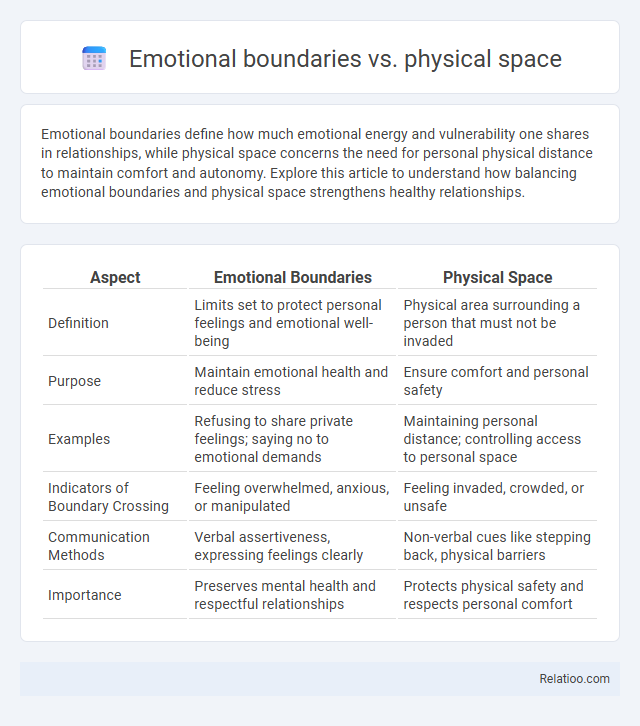Emotional boundaries define how much emotional energy and vulnerability one shares in relationships, while physical space concerns the need for personal physical distance to maintain comfort and autonomy. Explore this article to understand how balancing emotional boundaries and physical space strengthens healthy relationships.
Table of Comparison
| Aspect | Emotional Boundaries | Physical Space |
|---|---|---|
| Definition | Limits set to protect personal feelings and emotional well-being | Physical area surrounding a person that must not be invaded |
| Purpose | Maintain emotional health and reduce stress | Ensure comfort and personal safety |
| Examples | Refusing to share private feelings; saying no to emotional demands | Maintaining personal distance; controlling access to personal space |
| Indicators of Boundary Crossing | Feeling overwhelmed, anxious, or manipulated | Feeling invaded, crowded, or unsafe |
| Communication Methods | Verbal assertiveness, expressing feelings clearly | Non-verbal cues like stepping back, physical barriers |
| Importance | Preserves mental health and respectful relationships | Protects physical safety and respects personal comfort |
Understanding Emotional Boundaries
Understanding emotional boundaries is essential for maintaining healthy relationships and protecting your mental well-being. Emotional boundaries define how much you allow others to influence your feelings and thoughts, distinguishing your emotions from theirs. Unlike physical space, which involves tangible distance, emotional boundaries require clear awareness and communication to ensure your feelings remain your own.
Defining Physical Space in Relationships
Physical space in relationships refers to the tangible distance or proximity individuals maintain to feel comfortable, safe, and respected within personal interactions. Unlike emotional boundaries that protect your feelings and mental well-being, physical space defines the physical environment that influences intimacy and personal comfort levels. Recognizing and honoring your partner's need for physical space fosters trust and balance, preventing feelings of suffocation or intrusion.
Key Differences Between Emotional and Physical Boundaries
Emotional boundaries define the limits of personal feelings and vulnerability, safeguarding mental well-being by controlling how much emotional information one shares or absorbs from others. Physical space boundaries involve the tangible distance maintained around one's body to ensure comfort and safety, such as personal space or touch preferences. While emotional boundaries regulate internal psychological limits, physical space boundaries manage external spatial limits, and both are crucial for healthy interpersonal relationships.
The Importance of Healthy Emotional Boundaries
Healthy emotional boundaries are essential for maintaining mental well-being and fostering respectful relationships by clearly defining personal limits in feelings and interactions. Unlike physical space, which involves tangible distance, emotional boundaries manage intangible aspects like empathy, vulnerability, and emotional energy. Prioritizing these boundaries prevents emotional exhaustion, reduces anxiety, and supports authentic connections by honoring individual emotional needs.
Respecting Personal Physical Space
Respecting personal physical space is essential for maintaining healthy emotional boundaries and fostering trust in relationships. Physical space refers to the tangible distance individuals require to feel comfortable, while emotional boundaries protect their psychological well-being. Honoring these distinctions prevents discomfort and promotes mutual respect in social interactions.
Signs of Violated Emotional Boundaries
Signs of violated emotional boundaries include feeling drained, overwhelmed, or guilty after interactions, indicating others are overstepping your emotional limits. You may notice a constant need to apologize or justify your feelings, which reflects discomfort in asserting your personal emotional space. Recognizing these signs helps you protect your emotional well-being, distinct from physical space or general personal space concerns.
Recognizing Intrusions on Physical Space
Recognizing intrusions on physical space involves understanding the non-verbal cues and personal comfort zones that signal when someone is encroaching beyond acceptable limits. Emotional boundaries differ by focusing on protecting feelings and psychological well-being, while physical space deals with visible and tangible proximity. Maintaining clear physical boundaries is crucial to prevent discomfort, stress, and potential conflicts arising from unwanted closeness or invasions.
Strategies to Communicate Emotional Needs
Effective communication of emotional needs requires clearly setting emotional boundaries by expressing feelings honestly without blame. Utilizing assertive language helps define personal limits while respecting others' space, avoiding physical intrusion. Combining verbal cues with nonverbal signals strengthens understanding and fosters a safe environment for emotional exchange.
Establishing Safe Physical Boundaries
Establishing safe physical boundaries is crucial for maintaining personal space and ensuring comfort in interpersonal interactions. Emotional boundaries define your limits in relationships, while physical space refers to the tangible area around your body that you protect to feel secure. Clear communication about your physical boundaries helps others respect your space, fostering a sense of safety and trust.
Balancing Emotional Connection and Personal Space
Balancing emotional connection and personal space requires understanding the difference between emotional boundaries, physical space, and space overall. Emotional boundaries protect your feelings and well-being by defining how much emotional energy you share, while physical space refers to the tangible distance needed for comfort and safety. Maintaining clear emotional boundaries alongside respecting physical space ensures healthy relationships where your needs for intimacy and autonomy are both honored.

Infographic: Emotional boundaries vs Physical space
 relatioo.com
relatioo.com